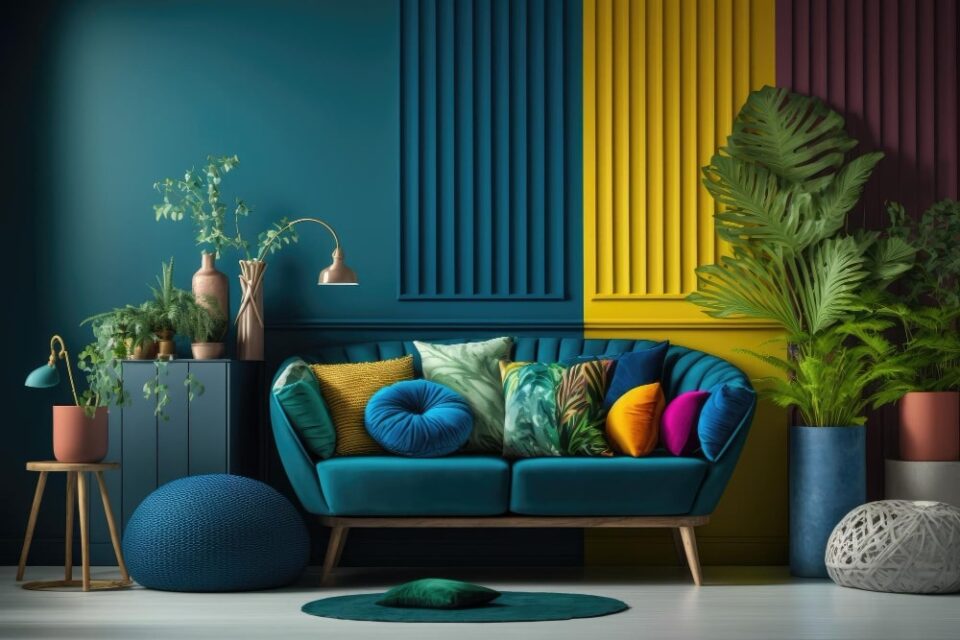Introduction:
The power of color in changing spaces is often overlooked. When you walk into the room, the wall color is one of the first things that affects your senses. It sets the mood, influences your emotions, and alters how you perceive the space.Selecting the right paint colors can dramatically transform the atmosphere of your home. Lighter shades, like soft pastels and neutral tones, reflect natural light, making rooms feel more spacious and bright. Darker colors, on the other hand, absorb light, creating a cozy and intimate ambiance, especially in well-lit areas. By carefully choosing paint colors that complement the lighting conditions in each room, you can enhance the overall aesthetics and mood, resulting in inviting and harmonious living spaces.
Five Key Considerations for Thoughtful Color Selection
Setting out on a quest to invigorate your living areas via deliberate color selection is a life-changing undertaking. The entire ambience and comfort of a space are greatly impacted by the colors that you choose to paint your walls. When selecting the ideal color palette, take into account these five important aspects to guarantee a balanced and visually pleasant outcome:
- Choosing the Right Paint:
- When selecting paint, consider the room’s purpose and how it will be used. Highly trafficked areas like entryways and hallways may need more durable and stain-resistant paint. Kitchens and dining rooms could benefit from vibrant or stimulating colors, while bedrooms and living rooms may work better with soothing, calming hues.
- Lighting Matters:
- The amount of natural light in a space affects how the color will appear. Think about the light intensity and window placement. Rooms with plenty of sunlight can handle a wider range of colors, while darker areas may look better with lighter shades to enhance brightness.
- Seasonal Influences:
- The time of year can also impact your color choices. In spring and summer, lighter, brighter colors often create a fresh, airy feel in the home. Conversely, autumn and winter may inspire the use of warmer, deeper tones, contributing to a cozy, snug atmosphere.
- Room Size and Layout:
- The size and layout of a space also influence the ideal paint color. Lighter hues can make smaller areas appear larger and more open. On the flip side, darker colors can make larger rooms feel cozier and more inviting. When selecting your color palette, be mindful of the proportions and arrangement of the space.
- The Cost Factor:
- A Practical Consideration When considering the impact of colors on mood, it’s important to think about the cost of residential interior painting. Budgeting for a painting project means balancing the desired look with what’s financially realistic. The cost can vary based on the size of the room, the quality of the paint, and the complexity of the job. Choosing high-quality paint may be more expensive upfront, but it can be cost-effective in the long run because of its durability and better coverage.
Color Coordination and Personal Preferences and Style:
- Use complementary colors to create a smooth transition between spaces. Test out paint samples to ensure the final design is cohesive and well-balanced. Personal Preferences and Style The colors you select should reflect your unique style and preferences. Think about the emotions you want the room to evoke and the atmosphere you want to create. When you choose colors that complement your tastes, whether through a vibrant accent wall or a neutral background, the space will feel truly comfortable and showcase your individuality.
How Colors Can Transform Your Space?
Commercial Spaces:
Color plays a vital role in employee productivity and customer perception within commercial settings. Aligning colors with the brand strengthens the company’s identity, while a harmonious color scheme creates a welcoming and cheerful environment. By thoughtfully considering lighting and color psychology, the workplace can effectively reflect the company’s goals and values through a visually appealing and cohesive design.
Residential Areas:
Colors in homes reflect personal preferences and influence the overall ambiance. Cooler shades of blue and green invoke a sense of serenity in bedrooms, while warmer tones like yellow and red foster a cozy and inviting atmosphere in living areas. Accent colors add unique character, while neutral tones provide versatility. Carefully selected colors enhance the aesthetic appeal and help create a peaceful, comfortable living space.
Workspace Colors:
The colors in an office space can significantly impact employee morale and productivity. Blues and greens are energizing colors that help people focus, while splashes of vibrant colors can inspire creativity. Neutral tones communicate professionalism and create a calm yet inspiring atmosphere. Using brand colors can also reinforce a company’s identity.
Basement Spaces:
In basement areas that often lack natural light, light and neutral hues can help brighten the space. Using white, pastel, or gentle earth tones can create an open and welcoming atmosphere. Adequate lighting is crucial to accentuate the color choices and prevent the room from feeling small or gloomy. Adding mirrors or reflective surfaces can also help improve the perception of light and space.
Outdoor Spaces:
Natural colors like green and brown help outdoor spaces blend in with their surroundings. Using vibrant accent colors can highlight certain features. Earthy tones provide a calming backdrop, while bolder selections add flair. Weather-resistant paint ensures longevity and creates an attractive, cohesive outdoor setting.
Children’s Spaces:
Color has a significant impact on a child’s mood and development. Bright primary colors inspire creativity in playrooms, while soft pastels create soothing nurseries. Color combinations that grow with a child enable flexibility as they get older. Safety is of utmost importance, and non-toxic paints ensure a healthy environment. Themed colors or murals can enhance an imaginative and lively space.
Retail Environments: Colors play a crucial role in how customers perceive and interact with a store. Carefully chosen color schemes can guide customers through the space and create a welcoming atmosphere. Warm tones at the entrance make for a pleasant first impression, while unique brand colors help customers recognize the business. Vibrant accent colors draw attention to displays and encourage exploration. Proper lighting ensures accurate color representation, enhancing the overall shopping experience.
Conclusion:
In conclusion, the colors in a space have a tremendous influence on the overall atmosphere. Beyond just aesthetics, thoughtfully choosing colors can affect our feelings, attitudes, and how well our living spaces function. Colors have the power to evoke emotions of creativity, relaxation, or enthusiasm, turning areas into unique havens. By considering factors like purpose, natural lighting, room dimensions, coordination, and personal preferences, one can use color theory to create a visually pleasing and harmonious environment. Since color has the ability to influence our experiences, improve our well-being, and give our surroundings a cozy, distinctive feel, carefully selecting colors is crucial. Ultimately, colors are dynamic tools for creating environments that speak to our individuality and enhance our quality of life.

